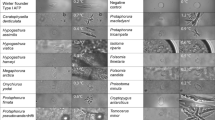Abstract
Antarctic springtails are exemplars of extreme low temperature adaptation in terrestrial arthropods. This paper represents the first examination of such adaptation in the springtail, Gressittacantha terranova. Acclimatization state was measured in field-fresh samples over a 22-day period at the beginning of the austral summer. No evidence of temperature tracking was observed. Mean temperature of crystallization (T c) for all samples was −20.67 ± 0.32°C and the lowest T c recorded was −32.62°C. Ice affinity purification was used to collect antifreeze proteins (AFPs) from springtail homogenate. The purified ice fraction demonstrated both thermal hysteresis activity and recrystallisation inhibition. Growth-melt observations revealed that ice crystals grow normal to the c-axis (basal plane). Reverse-phased HPLC produce one clearly resolved peak (P1) and one compound peak (P2). Mass spectrometry identified the molecular mass of P1 as 8,599 Da. The P1 protein was also the most prominent in P2, although additional peptides of 6–7 KDa were also prominent. The main AFP of the Antarctic springtail, G. terranova has been isolated, although like other AFP-expressing arthropods, it shows evidence of expressing a family of AFPs.







Similar content being viewed by others
Abbreviations
- AFP:
-
Antifreeze protein
- HPLC:
-
High performance liquid chromatography
- RI:
-
Recrystallisation inhibition
- T c :
-
Temperature of crystallization
- TH:
-
Thermal hysteresis
References
Bale JS (1993) Classes of insect cold hardiness. Funct Ecol 7:751–753
Bale JS (1996) Insect cold hardiness: a matter of life and death. Eur J Entomol 93:369–382
Block W, Duman JG (1989) Presence of thermal hysteresis producing antifreeze proteins in the Antarctic mite, Alaskozetes antarcticus. J Exp Zool 250:229–231
Cannon RJC, Block W (1988) Cold tolerance of microarthropods. Biol Rev 63:23–77
Duman JG (2001) Antifreeze and ice nucleator proteins in terrestrial arthropods. Ann Rev Physiol 63:327–357
Duman JG, Bennett V, Sformo T, Hochstrasser R, Barnes BM (2004) Antifreeze proteins in Alaskan insects and spiders. J Insect Physiol 50:259–266
Graham LA, Davies PL (2005) Glycine-rich antifreeze proteins from snowfleas. Science 310:461
Graham LA, Liou Y, Walker VK, Davies PL (1997) Hyperactive antifreeze protein from beetles. Nature 388:727–728
Grimstone AV, Mullinger AM, Ramsay JA (1968) Further studies on the rectal complex of the mealworm, Tenebrio molitor. Philos. Trans. R. Soc. London Ser B 253:343–382
Hawes TC, Couldridge CE, Bale JS, Worland MR, Convey P (2006a) Habitat temperature and the temporal scaling of cold hardening in the high Arctic collembolan, Hypogastrura tullbergi (Schäffer). Ecol Entomol 31:450–459
Hawes TC, Bale JS, Convey P, Worland MR (2006b) Ecologically realistic modalities in arthropod supercooling point distributions. Eur J Entomol 103:717–723
Hawes TC, Bale JS, Worland MR, Convey P (2008) Trade-offs between microhabitat selection and physiological plasticity in the Antarctic springtail, Cryptopygus antarcticus (Willem). Polar Biol 31:68–689
Hawes TC, Torecelli G, Stevens MI (2010) Haplotype diversity in the Antarctic springtail, Gressittacantha terranova, at fine spatial scales—a Holocene twist to a Pliocene tale. Antarct Sci 22:766–773
Hopkin SP (1997) Biology of the Springtails. Oxford University Press, Oxford
Knight CA (2000) Adding to the antifreeze agenda. Nature 406:249–250
Kristiansen E, Zachariassen KE (2005) The mechanism by which fish antifreeze proteins cause thermal hysteresis. Cryobiology 51:262–280
Kuiper MJ, Lankin C, Gauthier SY, Walker VK, Davies PL (2003) Purification of antifreeze proteins by adsorption to ice. Biochem Biophys Res Comm 300:645–648
Li N, Andorfer CA, Duman JG (1998) Enhancement of insect antifreeze protein activity by solutes of low molecular mass. J Exp Biol 201:2243–2251
Patterson JL, Duman JF (1979) Composition of a protein antifreeze from larvae of the beetle, Tenebrio molitor. J Exp Zool 210:361–367
Ramsay RA (1964) The rectal complex of the mealworm, Tenebrio molitor L. Coleoptera, Tenebrionidae. Philos Trans R Soc London Ser B 248:279–314
Raymond JA, DeVries AL (1977) Adsorption inhibition as a mechanism of freezing resistance in polar fishes. PNAS 74:2589–2593
Scotter AJ, Marshall CB, Graham LA, Gilbert JA, Garnham CP, Davies PL (2006) Basis for hyperactivity of antifreeze proteins. Cryobiology 53:229–239
Stevens MI, Greenslade P, Hogg ID, Sunnocks P (2006) Southern hemisphere springtails: could any have survived glaciation of Antarctica? Mol Biol Evol 23:874–882
Walters KR, Serianni AS, Sformo T, Barnes BM, Duman JG (2009) A nonprotein thermal hysteresis-producing xylomannan antifreeze in the freeze-tolerant Alaskan beetle Upis ceramboides. PNAS 106:20210–20215
Wharton DA, Barrett J, Goodall G, Marshall CJ, Ramlov H (2005) Ice-active proteins from the Antarctic nematode Panagrolaimus davidi. Cryobiology 51:198–207
Worland MR, Block W (2003) Desiccation stress at sub-zero temperatures in polar terrestrial arthropods. J Insect Physiol 49:193–203
Worland MR (2005) Factors that influence freezing in the sub-Antarctic springtail Tullbergia antarctica. J Insect Physiol 51:881–894
Worland MR, Convey P (2008) The significance of the moult cycle to cold tolerance in the Antarctic collembolan Cryptopygus antarcticus. J Insect Physiol 54:1281–1285
Wu DW, Duman JG, Cheng CC, Castellino FJ (1991) Purification and characterization of antifreeze proteins from larvae of the beetle Dendroides canadensis. J Comp Physiol 161:271–278
Zachariassen KE, Husby JA (1982) Antifreeze effect of thermal hysteresis agents protects highly supercooled insects. Nature 298:865–867
Zettel J (1984) Cold hardiness strategies and thermal hysteresis in Collembola. Rev Ecol Biol Sol 21:189–203
Acknowledgments
TCH was funded by the Leverhulme Trust. Thanks to Antarctic NZ for logistical support.
Author information
Authors and Affiliations
Corresponding author
Additional information
Communicated by G. Heldmaier.
Rights and permissions
About this article
Cite this article
Hawes, T.C., Marshall, C.J. & Wharton, D.A. Antifreeze proteins in the Antarctic springtail, Gressittacantha terranova . J Comp Physiol B 181, 713–719 (2011). https://doi.org/10.1007/s00360-011-0564-4
Received:
Revised:
Accepted:
Published:
Issue Date:
DOI: https://doi.org/10.1007/s00360-011-0564-4




